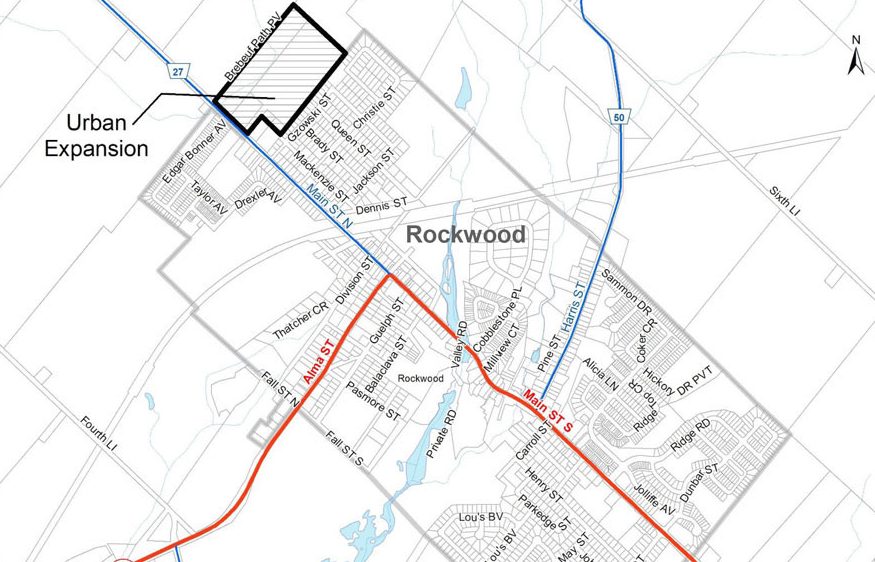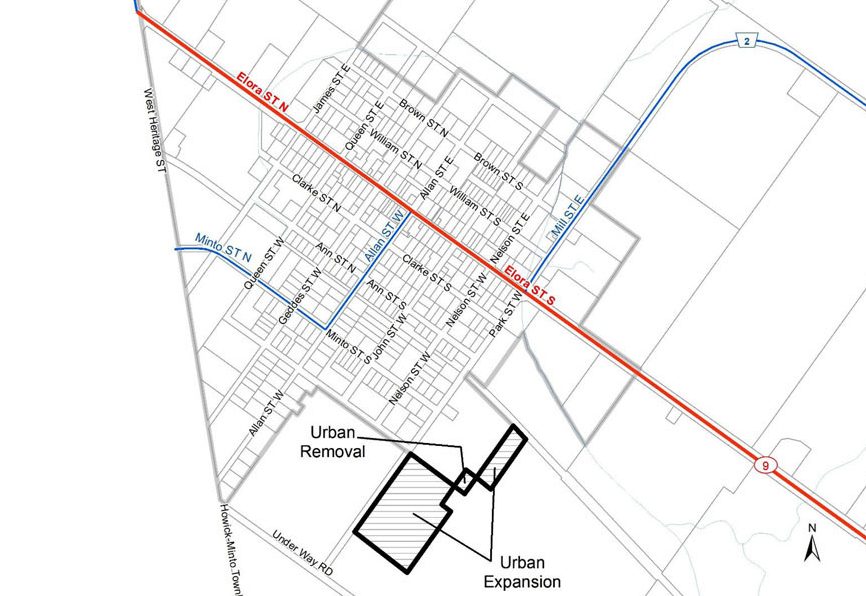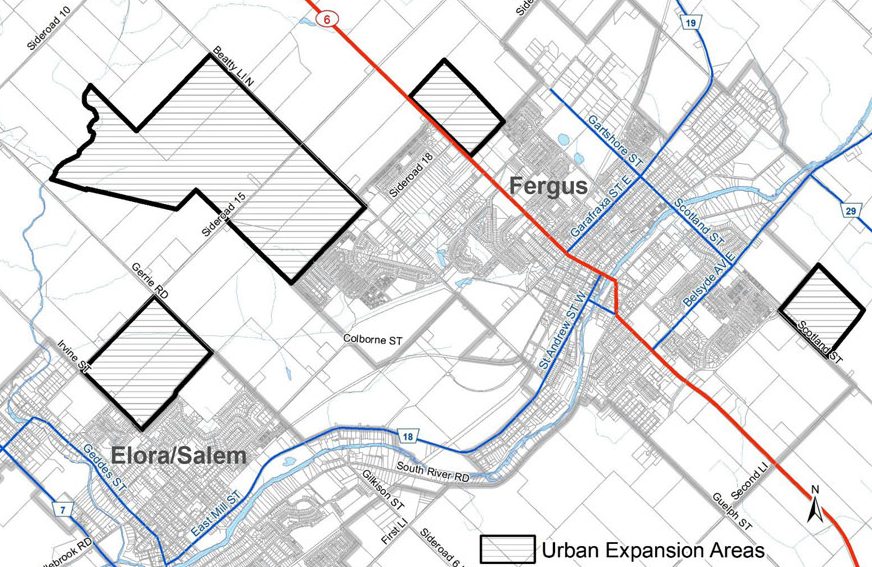WELLINGTON COUNTY – The provincial government has made unilateral changes to an amendment to Wellington County’s Official Plan, adding more than 1,000 acres of mostly agricultural land to urban boundaries.
The boundary extensions, which were among modifications directed in the Ministry of Municipal Affairs’ April 11 approval of Official Plan Amendment (OPA) 119, include:
- just over 1,000 acres around Fergus and Elora in Centre Wellington;
- 37 acres adjacent to Rockwood in Guelph/Eramosa; and
- about 15 acres on the southwest corner of Clifford in the Town of Minto.
An April 13 staff report to the county’s planning committee, prepared prior to the OPA 119 decision which came into effect April 12, indicated that as of March 31, the overall need for boundary expansions throughout Wellington County could be up to 1,200 acres after accounting for recommended employment area conversions.
However, urban boundary extension requests were not included by the county in OPA 119.
The county report includes potential boundary extensions in Erin, Mapleton and Wellington North, as well as Centre Wellington, Minto and Guelph/Eramosa.
In a May 5 telephone interview with the Advertiser, Sarah Wilhelm, manager of policy planning for the county, said the province’s intervention preempts some of the work being done as part of the county’s Municipal Comprehensive Review process.
“The purpose of [OPA 119] was to set the stage for the growth that would be coming and to create a structure that meets provincial policy,” said Wilhelm.
“It wasn’t intended to consider urban expansions at all.”
Wilhelm added the “lack of public consultation” in the province’s decision is concerning.
Centre Wellington changes
Centre Wellington Mayor Shawn Watters said the 1,000-acre urban boundary expansion “had been floating around for a while. But when the province started to change the rules, we saw the opportunity to go up and intensify.
“We would not need to expand the boundary. That’s what we were working towards,” he said.
He noted it’s easier and less expensive to provide services – like water, wastewater, snow removal and so on – when properties are closer together and there is more density.
Though the decision by the province is not appealable, “there is still a process in determining what’s serviceable,” Watters said.
“We’ll identify the land that makes sense to add servicing. The township and county have a good understanding of those fundamentals.”
He said the population forecast goes to 2051 and he hopes that by intensifying and adding density, the newly-identified lands can remain productive farmland.
The land included in the expanded urban boundary around Elora and Salem and along Scotland Street in Fergus is not surprising to Watters, as development is going on there now, in a fashion.
But for the newly identified area north of Fergus on Beatty Line that straddles Sideroad 15 all the way up to Irvine Creek, Watters called it a “curious” decision by the province.
People and goods and services generally travel east and west or south, he said.
“There are only so many crossings across the Grand River,” he said. “It really makes more sense to develop south.
“And if we do extend to Irvine Creek, I don’t think (the province) understands how that creek works.”
Watters is hopeful the township won’t have to expand into prime agricultural farmland to meet the housing targets set out by the province.
“We are a creature of the province, and we have to play the cards we’re dealt,” he said.
“We’re going to figure it out. But if the province wants to expedite housing and growth, it’s important to talk with the local municipalities.”
While the Centre Wellington boundary extensions are the most substantial, Wilhelm said there were some surprises in the other decisions from the province as well.
“The Clifford one … we were aware of the request (for expansion). I don’t know that the (Town of Minto) will be opposed to it necessarily,” she said.
“But the Rockwood one, there was no need for additional land identified through our technical work (there) … and they won’t have that additional municipal sewage capacity.”
Rockwood changes
Mayor Chris White said an application for the additional Guelph/Eramosa land, located near the fire hall and police station at the northern entrance to Rockwood, indicates a plan for “three or four hundred homes.”
“But we don’t have the infrastructure to support this,” White told the Advertiser on May 5.
“The bottom line is, we don’t have any sewage capacity.”
The City of Guelph provides wastewater services for Rockwood and once already-approved developments in the village are complete, “then we’re maxed out,” the mayor added.
To make things more difficult, the land in question is zoned prime agriculture and there is a wetland in the area, White explained.
“There was no consultation with us whatsoever,” he said.
“It would have been nice if [the province] had some conversations with us … I’m just not sure how they’re going to do this.”

Map showing approximate area of urban expansion in Rockwood. County of Wellington image
Clifford changes
Minto Mayor Dave Turton said a developer had requested urbanization of the 15 acres brought into Clifford under OPA 119.
“But we were recommending expansion in other parts of Minto. And so we weren’t totally in favour of that,” he said.
“But it was the Minister of Municipal Affairs and Housing …. he approved the expansion request. So it was out of our hands.”
Turton, who noted town officials were “surprised” by the decision, said the municipality would have preferred to see urban boundary expansion in Palmerston, where “a lot of the jobs” are.
While the province’s decision is not appealable, Wilhelm said there will be work needed by the county and lower-tier municipalities to implement the changes.
“The land has been added to the boundary, but it doesn’t have any land use designations associated with it,” she said.
“So basically, what we can say right now is it’s urban land. It’s been approved, but it doesn’t have any land use designations. It would also need development plans and a lot of planning around it to make it happen.”

Map showing approximate area of urban expansion in Clifford. County of Wellington image
WFA: changes ‘ridiculous’
Asked what the decision means for anyone currently farming the newly-urban lands within the county, Wilhelm said, “They can continue farming for sure. The zoning is probably still agricultural. And then, I guess, eventually the intent would be for it to be urbanized.”
Wilhelm confirmed that means the land in the extended urban zones could now be sold for non-agricultural uses.
“It’s a big change,” she stated.
Wellington Federation of Agriculture (WFA) president Janet Harrop told the Advertiser the federation was aware of preliminary reports from the county indicating “they would need about 1,000 acres around Centre Wellington to be able to meet the growth targets.”
However, she noted, “We’ve been working with them to try to lessen that, as a federation, by more in-fill, more softening the lines of the urban boundary and increasing intensification within the urban boundary to be able to reduce that amount.”
Harrop said it’s “really disturbing for agriculture … that the province can just override any kind of planning that the local tiers do.
“So if a developer comes through and says, ‘The planning process at the county is saying I can’t do this’ and the Minister of Housing reviews it, they can come in and say, ‘Yeah, you can go ahead and do it’ … that’s really, really disturbing.
“It kind of contravenes any local planning that’s being done.”
Harrop called the province’s push to build homes on farmland “absolutely ridiculous.
“Agricultural land is the foundation of our business. It’s not intended to build homes on and, from an economic perspective, it’s been shown over and over again that building homes in the in the rural area costs the municipality a lot more money to be able to provide services,” she said.
Harrop noted the WFA is also concerned that intensifying residential development into rural areas will make it difficult for farmers to build livestock barns, given separation distance requirements.
She also pointed out there is a limited amount of good farmland available.
“Only five per cent of the land base in Ontario is prime agricultural and all of the (farm) land in Centre Wellington is prime agricultural,” she said.
“So, it’s unbelievable wanting to change 50 years of good planning with a swipe of a pen. It’s really upsetting.”
Harrop also pointed out the push to build on farmland contradicts the province’s stated goals in other areas.
“For government that says they want us to increase our food production by 30% so that Ontario can be more self-sufficient, now they want to encroach and incorporate all of this prime agricultural land and pave it over with homes,” she said.
“I’ve never seen anything like this from a planning perspective for agriculture.”
Planning process upended
Wilhelm said the current changes, combined with a new provincial policy statement expected in the fall, have upended the county’s planning process.
“We’re doing a full official plan review right now. And part of the review is something called a Municipal Comprehensive Review and it’s unique to the growth plan,” she explained.
“But this new proposed planning document eliminates that term and the whole process for it.”
Language in the proposed provincial policy document appears to indicate growth targets previously imposed by the province, which municipalities have been working towards for years, are less settled.
“We are reviewing our work plan, to regroup and continue moving forward … But it creates a bit of a weird time lag for us, because the province is signaling the new provincial policy document will come into effect in the fall,” said Wilhelm.
“But in the meantime, we want to continue with the work that we’re doing. We’ll still need to continue doing settlement boundary expansion work, because we have other needs and other municipalities in the county.”
She cited employment land needs that will have to be considered and “probably some other areas of expansion that would be logical based on servicing.”
While declining to identify specific properties due to privacy concerns, Wilhelm said some of the properties within a large swath of land between Fergus and Elora that is now within urban boundaries had been subject to request for inclusion.
“Most of them were on our radar in terms of requests. But there are some lands north of Sideroad, 15, that we hadn’t received a request on,” she pointed out.
“Certainly, there are developers that have interests in lands, that have made comments that have come through. I’m not sure of the status, whether they purchased, or … what arrangements they have.”
OPA 119 was submitted for approval in September and re-opened for comment in December. Wilhelm said she isn’t sure what methodology the province used in the meantime to arrive at the modifications.
“I’m not aware of any technical assessment that was done by the province to review the criteria that we would normally need to review when we would look at urban expansion requests,” she stated, noting servicing requirements haven’t been addressed.
“Just the fact that we didn’t have an opportunity to provide input, or even any advance warning or notice of this happening, is probably the biggest concern.”
Wilhelm continued, “I think the whole thing is unusual, really.
A first for Wellington
“I know other municipalities have had lands added,” she said, citing recent provincial moves regarding the City of Hamilton, Halton Region and Waterloo Region.
However, she added, Wellington County has “never been through a process where we’ve had … lands added en masse the way that they’ve done here.”
All told, the province’s decision contains 33 modifications to OPA 119.
The decision states the modifications were made “to address provincial policy direction related to Indigenous engagement, accommodating housing options to the 2051 planning horizon, settlement areas, employment areas, and Greenbelt mapping.”
A report set for discussion at the county planning committee meeting on May 11 notes county staff generally support 19 modifications, “which are relatively minor text changes to conform with current provincial policy.”
The reports states: “Changes which remove references to single detached and semidetached dwellings being the dominant form of housing in the county are in keeping with the county’s attainable housing strategy.”
The report also points out “urban boundary expansions were not originally part of OPA 119” and county staff “are unaware of any technical evaluations completed by the province to ensure that the expansions met current provincial, county and local policy, municipal servicing requirements, etc.”
-With files from Joanne Shuttleworth and Chris Daponte




